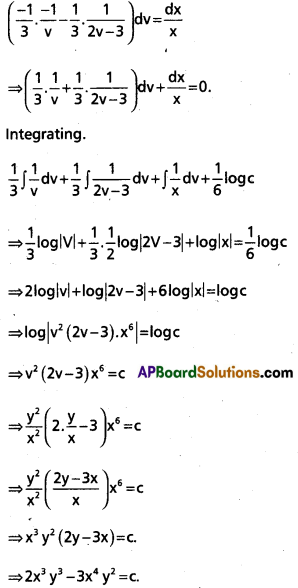Access to a variety of AP Inter 2nd Year Maths 2B Model Papers and AP Inter 2nd Year Maths 2B Question Paper March 2019 allows students to familiarize themselves with different question patterns.
AP Inter 2nd Year Maths 2B Question Paper March 2019
Time : 3 Hours
Max. Marks : 75
Note : This question paper consists of three sections A, B and C.
Section – A (10 × 2 = 20)
I. Very Short Answer Type Questions.
- Attempt all questions.
- Each question carries two marks.
Question 1.
Find the equation of the circle for which the points (4, 2), (1, 5) are the end points of a diameter.
Solution:
The equation of the circle for which the points (4, 2), (1, 5) are the end points of a diameter is
(x – x1) (x – x2) + (y – y1) (y – y2) = 0
⇒ (x – 4) (x – 1) + (y – 2) (y – 5) = 0
⇒ x2 – x – 4x + 4 + y2 – 5y – 2y + 10 = 0
⇒ x2 + y2 – 5x + 7y + 14 = 0.
Question 2.
Find the value of k if the points (4, 2) and (k, -3) are conjugate points with respect to the circle x2 + y2 – 5x + 8y + 6 = 0.
Solution:
Let S ≡ x2 + y2 – 5x + 8y + 6 = 0.
Since the points (4, 2) and (k, -3) are conjugate with respect to the circle s = 0.
∴ S12 = 0.
⇒ x1x2 + y1y2 – \(\frac{5}{2}\)(x1 + x2) + 4 (y1 + y2) + 6 = 0.
⇒ 4k – 6 – \(\frac{5}{2}\) (4 + k) + 4 (2 – 3) + 6 = 0.
⇒ 4k – 6 – 10 – \(\frac{5}{2}\) k – 4 + 6 = 0.
⇒ \(\frac{3}{2}\) k – 14 = 0
⇒ \(\frac{3}{2}\) k = 14 ⇒ 3k = 28
⇒ k = \(\frac{28}{3}\).
Question 3.
Find the equation of the radical axis of the circles x2 + y2 – 4x + 6y – 7 = 0, 4(x2 + y2) + 8x + 12y – 9 = 0.
Solution:
Let s ≡ x2 + y2 + 4x + 6y – 7 = 0.
S’ ≡ x2 + y2 + 2x + 3y – \(\frac{9}{4}\) = 0.
The equation of the radical axis of the circles s = 0, s’ = 0 is s – s’ =0
⇒ (x2 + y2 + 4x + 6y – 7) – (x2 + y2 + 2x + 3y – \(\frac{9}{4}\) = 0.
⇒ x2 + y2 + 4x + 6y – 7 – x2 – y2 – 2x – 3y + \(\frac{9}{4}\) = 0.
⇒ 2x + 3y – (7 – \(\frac{9}{4}\)) = 0
⇒ 2x + 3y – \(\left(\frac{28-9}{4}\right)\) = 0
⇒ 2x + 3y – \(\frac{19}{4}\) = 0
⇒ 8x + 12y – 19 = 0.
Question 4.
Find the equation of the tangent to the parabola x2 – 4x – 8y + 12 = 0 at (4, \(\frac{3}{2}\))
Solution:
Let s ≡ x2 – 4x – 8y + 12 = 0.
The equation of the tangent to the parabola s = 0 at (4, \(\frac{3}{2}\)) is s1 = 0.
⇒ xx1 – 2 (x + x1) – 4 (y + y1) + 12 = 0.
⇒ x (4) – 2 (x + 4) – 4 (y + \(\frac{3}{2}\)) + 12 = 0
⇒ 4x – 2x – 8 – 4y – 6 + 12 = 0.
⇒ 2x – 4y – 2 = 0
⇒ x – 2y – 1 = 0.
Question 5.
Find the product of lengths of the perpendiculars from any point on the hyperbola \(\frac{x^2}{16}\) – \(\frac{y^2}{9}\) = 1 to its asymptotes.
Solution:
Given \(\frac{x^2}{16}\) – \(\frac{y^2}{9}\) = 1
Here a2 = 16, b2 = 9.
The product or lengths of the perpendiculars from any point on the hyperbola \(\frac{x^2}{16}\) – \(\frac{y^2}{9}\) = 1 to its asymptotes is \(\frac{a^2 b^2}{a^2+b}\) = \(\frac{144}{25}\) = \(\frac{16(9)}{16+9}\)
Question 6.
Evaluate: \(\int \frac{e^x(1+x)}{\cos ^2\left(x e^x\right)} d x\) on I ⊂ R \ {x ∈ R : cos (xe’) = 0}
Solution:
I = \(\int \frac{e^x(1+x)}{\cos ^2\left(x e^x\right)}\)dx
Let xex = t
(xex + ex.1) dx = dt
ex (x + 1) dx = dt
∴ I = \(\int \frac{1}{\cos ^2 t}\) dt
= ∫Sec2t dt
= tant + c
= tan (xex) + c
∴ \(\int \frac{e^x(1+x)}{\cos ^2\left(x e^x\right)}\)dx = tan (xex) + c.
Question 7.
Evaluate : ∫\(\frac{d x}{(x+1)(x+2)}\).
Solution:
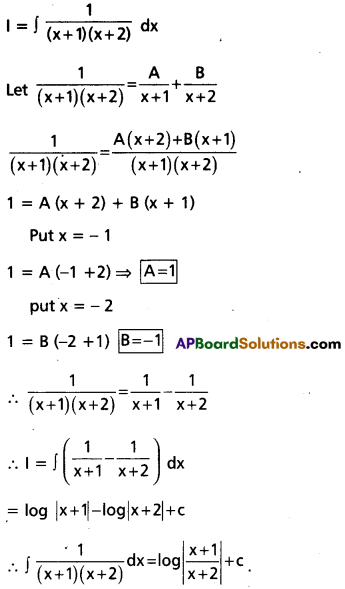
Question 8.
Evaluate : \(\int_0^1 \frac{d x}{\sqrt{3-2 x}}\).
Solution:
I = \(\int_0^1 \frac{d x}{\sqrt{3-2 x}} d x\)
Let 3 – 2x = t
o – 2dx = dt
dx = \(\frac{-1}{2}\)dt
L.L : x = 0 ⇒ t = 3
U.L : x = 1 ⇒ t = 1

Question 9.
Evaluate : \(\int_0^{\frac{x}{2}}\)sin6cos4 x dx
Solution:
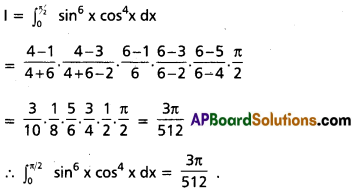
Question 10.
Form the differential equation corresponding to y = cx – 2c2, where c is a parameter.
Solution:
Given y = cx – 2c2
differentiating with respect to ‘x on both sides, we have \(\frac{d y}{d x}\) = c
substitute ‘c’ value in (1)
∴ y = x\(\frac{d y}{d x}\) – 2\(\left(\frac{d y}{d x}\right)^2\) is the required differential equation.
II. Short Answer Type Questions.
- Answer any five questions.
- Each question carries four marks.
Question 11.
If a point P is moving such that the lengths of tangents drawn from P to the circle x2 + y2 – 4x – 6y – 12 = 0 and x2 + y2 – 6x – 18y + 26 = 0 are in the ratio 2 : 3, then find the equation of the locus of P.
Solution:
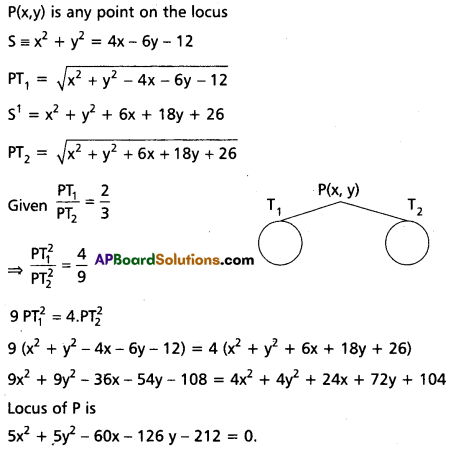
Question 12.
Find the equation of the circle passing through the points of intersection of the circles x2 + y2 – 8x – 6y – 21 = 0 x2 + y2 – 2x – 15 = 0 and (1, 2).
Solution:
Let S ≡ x2 + y2 – 8y – 6y + 21 = 0
S’ ≡ x2 + y2 – 2x – 15 = 0
S – S’ = x2 + y2 – 8x – 6y + 21 – x2 – y2 + 2x + 15
= 6x – 6y + 36
The equation of the circle passing through the points of intersection of the circles s = 0, S’ = 0 is
s + λ(S – S’) = 0
⇒ (x2 + y2 – 8x – 6y + 21) + λ(-6x – 6y + 36) = 0
If this circle passing (1, 2) then
(1 + 4 – 8 – 12 + 21) + λ(-6 – 12 + 36) = 0
⇒ 6 + 18λ = 0
⇒ 18λ = – 6
⇒ λ = \(\frac{-1}{3}\)
Hence required circle equation is
(x2 + y2 – 8x – 6y + 21) – \(\frac{1}{3}\) (-6x – 6y + 36) = 0
⇒ 3x2 + 3y2 – 24x – 18y + 63 + 6x + 6y – 36 = 0
⇒ 3x2 + 3y2 – 18x – 12y + 27 = 0
⇒ x2 + y2 – 6x – 4y + 9 = 0
Question 13.
Find the equation of the ellipse referred to its major and minor axes as the co-ordinate axes X, Y – respectively with latus rectum of length 4 and distance between foci 4\(\sqrt{2}\).
Solution:
Given Length of the latus rectum = 4
⇒ \(\frac{2 b^2}{a}\) = 4
⇒ \(\frac{a^2\left(1-e^2\right)}{a}\) = 2
⇒ a(1 – e2) = 2 ………. (1)
Given distance between foci = 4\(\sqrt{2}\)
⇒ 2ae = 4\(\sqrt{2}\)
⇒ ae = 2\(\sqrt{2}\)
⇒ e = \(\frac{2 \sqrt{2}}{a}\) ………. (2)
From (1)
a(1 – \(\frac{8}{a^2}\)) = 2
⇒ a\(\left(\frac{a^2-8}{a^2}\right)\) = 2
⇒ \(\frac{a^2-8}{a}\) = 2
⇒ a2 – 8 = 2a
⇒ a2 – 2a – 8 = 0
⇒ (a – 4) (a + 2) = 0
Since a > 0
∴ a = 4
From (2) e = \(\frac{2 \sqrt{2}}{4}\) = \(\frac{1}{\sqrt{2}}\)
b2 = a2(1 – e2) = 16(1 – \(\frac{1}{2}\)) = 16(\(\frac{1}{2}\)) = 8.
∴ Required ellipse equation is \(\frac{x^2}{16}\) + \(\frac{y^2}{8}\) = 1.
Question 14.
Show that the locus of the feet of the perpendicular’s drawn from foci to any tangent of the ellipse is the auxiliary circle.
Solution:
Equation of the ellipse is \(\frac{x^2}{a^2}\) + \(\frac{y^2}{b^2}\) = 1
Equation of the tangent to the ellipse is y = mx ± \(\sqrt{a^2 m^2+b^2}\)
⇒ y – mx ± \(\sqrt{a^2 m^2+b^2}\) ……….. (1)
Equation to the perpendicular from either focus (± ae, 0) on this tangent is
y – 0 = \(\frac{-1}{m}\) (x ± ae)
⇒ my = – (x ± ae)
⇒ x + my = ± ……. (2)
squaring and adding (1) and (2)
∴ (y – mx)2 + (x + mx)2 = a2m2 + b2 + a2e2
⇒ y2 – 2mxy + m2x2 + x + 2mxy + m2y2 = a2m2 + a2 – a2e2 + a2e2
⇒ (1 + m2)x2 + (1 + m2)y2 = (1 + m2)
⇒ x2 + y2 = a2
∴ The locus is the auxiliary circle concentric with the ellipse.
Question 15.
Find the equations of the tangents to the hyperbola x2 – 4y2 = 4 which are
(i) Parallel
(ii) Perpendicular to the line x + 2y = 0.
Solution:
Given hyperbola equation is x2 – 4y2 = 4
⇒ \(\frac{x^2}{4}\) + \(\frac{y^2}{1}\) = 1 ……… (1)
Here a2 = 4, b2 = 1
Given line equation is x + 2y = 0 …….. (2)
(i) Equation of a line parallel to (2) is x + 2y + k = 0
⇒ 2y = – x – k
⇒ y = –\(\frac{1}{2}\)x – \(\frac{k}{2}\)
If this line is a tangent to the hyperbola (1) then
c2 = a2m2 – b2
\(\left(\frac{-k}{2}\right)^2\) = 4\(\left(\frac{-1}{2}\right)^2\) – 1
\(\frac{k^2}{4}\) = 1 – 1
k2 = 0 ⇒ k = 0
∴ Equation to the required tangent is x + 2y = 0
ii) Equation of a line perpendicular to (2) is 2x – y + k = 0
⇒ y = 2x + k
If this line is a tangent to the hyperbola (1) then
c2 = a2 m2 – b2
k2 = 4 (2)2 – 1
k2 = 16 – 1 = 15
k = ± \(\sqrt{15}\)
∴ Equation to the required tangent is 2x – y ± \(\sqrt{15}\) = 0.
Question 16.
Find the area, of one of the curvilinear triangles bounded by y = sin x, y = cos x and X-axis.
Solution:
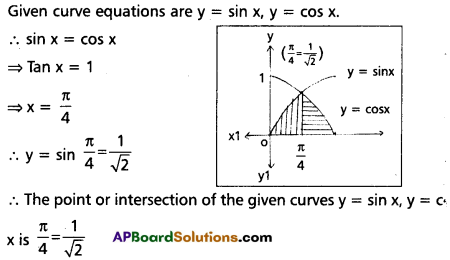
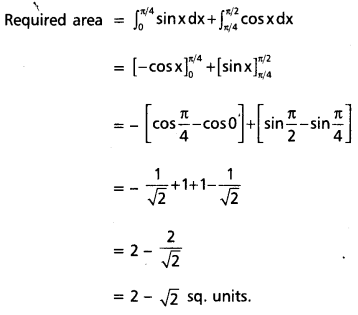
Question 17.
Solve : x(x – 1)\(\frac{d y}{d x}\) – y = x3 (x – 1)3.
Solution:
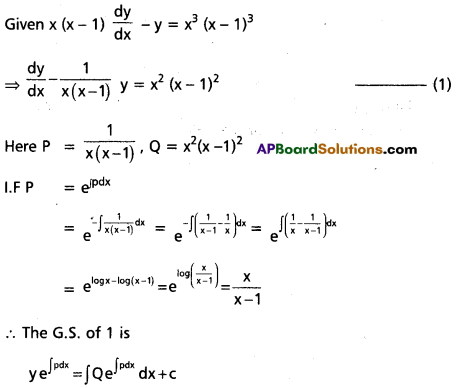
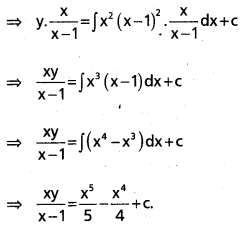
Section – C
III. Long Answer Type Questions.
- Answer any five questions.
- Each question carries seven marks.
Question 18.
Show that the following four points (1, 1), (-6, 0), (-2, 2), (-2, -8) are concyclic and find the equation of the circle on which they lie.
Solution:
Suppose the equation of the required circle is
x2 + y2 + 2gx + 2fy + c = 0 ………. (i)
This circle passes through A (1, 1)
1 + 1 + 2g + 2f + c = 0
⇒ 2g + 2f + c = 2 ………… (ii)
This circle passes through B (-6, 0)
36 + 0 + 12g + 0 + c = 0
-12g + c = -36 ……… (iii)
This circle passes through C (-2, 2)
4 + 4 + 4g + 4f + c = 0
-4g + 4f + c = -8 ……….. (iv)
(iii) – (iv) gives – 8g – 4f = 0
⇒ 2g + f = 7
(i) – (ii) gives 14g + 2f = 34
7g + f = 17 …….. (v)
Solving (iv) and (v) we get g = 2, f = 3
Putting g = 2, f = 3 in
⇒ 4 + 6 + c = -2
c = – 12
Required circle is x2 + y2 + 4x + 6y – 12 = 0
Substituting (-2, -8) in this above equation, we get 4 + 64 – 8 – 48 – 12 = 68 – 68 = 0
(-2, -8) satisfies the above equation
∴ A, B, C, D are concyclic.
Equation of the circle is x2 + y2 + 4x + 6y – 12 = 0.
Question 19.
Find the transverse common tangents of the circles
x2 + y2 – 4x – 10y + 28 = 0 and x2 + y2 + 4x – 6y + 4 = 0.
Solution:

= [1 + \(\frac{81}{4}\) – 4 – 10 × \(\frac{9}{2}\) + 28]
(-2x – y + 7)2 = (x2 + y2 – 4x – 10y + 28)
4x2 + y2 + 4xy – 28x – 14y + 4 = x2 + y2 – 4x – 10y + 28
3x2 + 4xy – 24x – 4y + 21 = 0
(3x + 4y – 21); (x – 1) = 0
3x + 4y – 21 = 0; x – 1 = 0.
Question 20.
Find the equation of the parabola whose focus is S (3, 5) and vertex is A (1, 3).
Solution:
Given s = (3, 5) and vertex A = (1, 3)
Since A is the mid point or SZ
∴ Z = 2A – S
= (2 – 3, 6 – 5)
= (-1, 1)
Slope of SZ = \(\frac{5-1}{3+1}=\) = \(\frac{4}{4}\) = 1
Slope of directrix = \(\frac{-1}{1}\) = -1
Equation of directrix is
y – 1 = – 1 (x + 1)
y – 1 = -x – 1

Question 21.
Evaluate : ∫\(\frac{\cos x+3 \sin x+7}{\cos x+\sin x+1}\) dx.
Solution:
Let I = \(\int \frac{\cos x+3 \sin x+7}{\cos x+\sin x+1}\) dx
Let cos x + 3 sin x + 7 = A \(\frac{d}{d x}\) (cos x + sin x + 1) + B (cos x + sin x + 1) + k
⇒ cos x + 3 sin x + 7 = A (- sin x + cos x) + B (cos x + sin x + 1) + k
– A + B = 3 ⇒ A – B + 3 = 0 ………. (1)
A + B = 1 ⇒ A + B – 1 = 0 ……… (2)
B + K = 7 ……….. (3)
(1) + (2) ⇒ 2 A + 2 = 0
⇒ A + 1 = 0
⇒ A = – 1
From (2)
– 1 + B – 1 = 0
⇒ B = + 2
From (3)
2 + k = 7
⇒ k = 5
∴ A = – 1, B = 2, k = 5
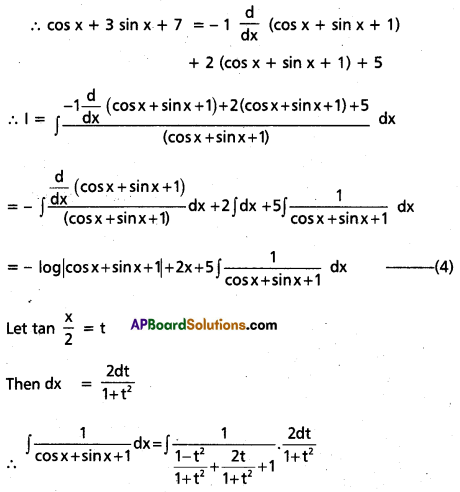

Question 22.
Obtain the reduction formula for In = ∫cosecnx dx, n being a positive integer, n ≥ 2 and deduce the value of ∫cosec5x dx.
Solution:
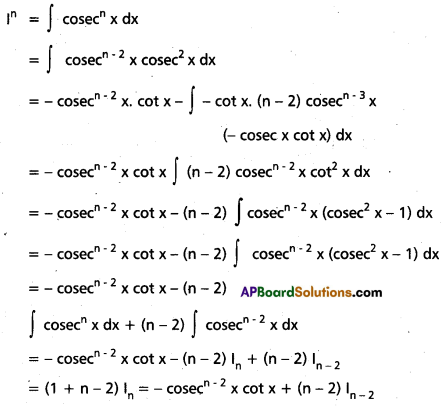
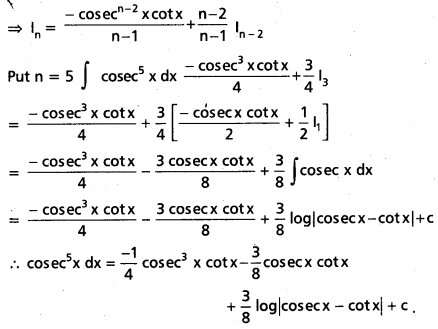
Question 23.
Evaluate : \(\int_0^{\frac{\pi}{4}}\) log (1 + tan x) dx.
Solution:
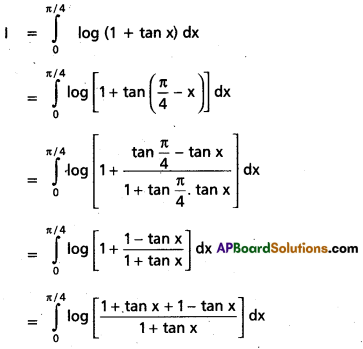
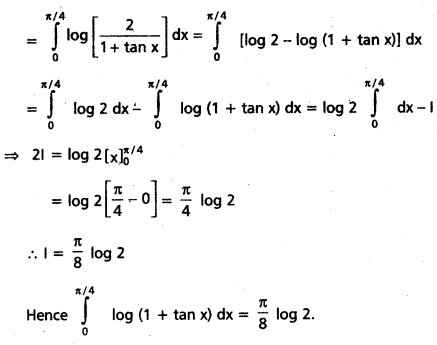
Question 24.
Solve : \(\frac{d y}{d x}\) = \(\frac{y^2-2 x y}{x^2-x y}\)
Solution:

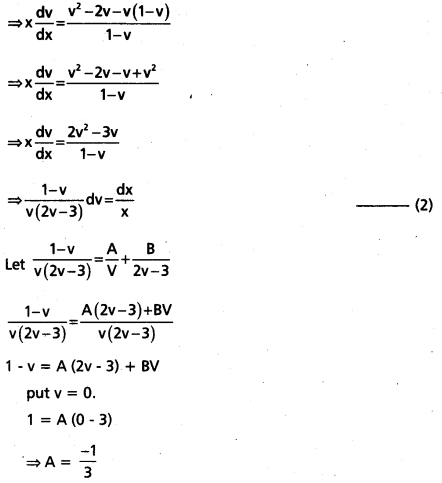
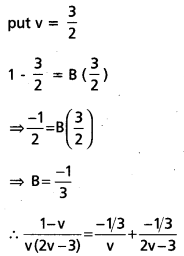
From (2)
